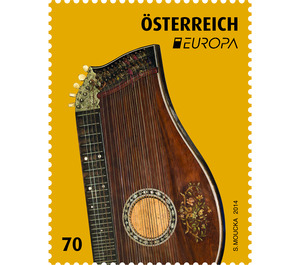Europe - Austria / II. Republic of Austria 2014 - 70 Euro Cent
Theme: Art & Culture
| Country | Austria / II. Republic of Austria |
| Issue Date | 2014 |
| Face Value | 70.00 |
| Edition Issued | 360,000 |
| Printing Type | offset |
| Stamp Type | Commemorative |
| Item Type | Stamp |
| Chronological Issue Number | 2471 |
| Chronological Chapter | OOS-OE2 |
| SID | 858433 |
| In 65 Wishlists | |
As every year, the European Postal Union of Posteurop has chosen a common brand theme, and this year, national musical instruments adorn the European stamps. The Austrian Post has opted for the zither, an instrument that, although it stands for alpine tradition, has long since found its way into modern ensembles. The zither belongs to the plucked instruments and is played lying at the table. The five melody strings are stretched over a fingerboard, they are gripped with the left hand and struck with a metal ring on the thumb of the right hand. The up to 37 free-risers are played with the remaining fingers of the right hand and accompany the melody. The zither in its present form exists only since the 19th century. However, there were wooden sound boxes that stretched over the strings already in antiquity - they were built and played in many different cultures. Already in the 7th century BC, the Greeks made music with the "Kithara", in the Bible, the zither is also often mentioned and in Asia, she had many regional primordial relatives. The predecessor of the alpine zither, however, is the medieval firewood, which was first described in the 16th century. The success story of the string instrument began around 1820 with the Viennese Johann Petzmayer, who further developed the zither and made it socially acceptable. The bourgeoisie, the nobility and even the emperor were enthusiastic about the instrument, which quite corresponded to the penchant for folklore in the Biedermeier period. Petzmayer was also invited to the Bavarian court, where he taught Duke Maximilian the zither, his daughter Sisi - the later Empress Elisabeth - finally brought it to the Vienna court. As a result, numerous zither schools were created, the instrument underwent many architectural changes and was exported worldwide. The Bavarian instrument maker Max Amberger created the first concert zither in 1862, two of the different types of stringing prevailed: today's prevailing mood in Munich and the deviant Viennese mood in which the world-famous Harry Lime theme of the film "The Third Man" was composed. Today, the zither is no longer considered a pure folk musical instrument. Especially since the 1960s, it is increasingly used in contemporary music such as jazz, blues and world music, but also in pop and rock. The motif of the brand was designed by the graphic artist Silvia Moucka, who designed numerous stamps for the Austrian Post. On display is an alpine concert zither in the traditional Salzburg style - the zither most commonly built and used today.


